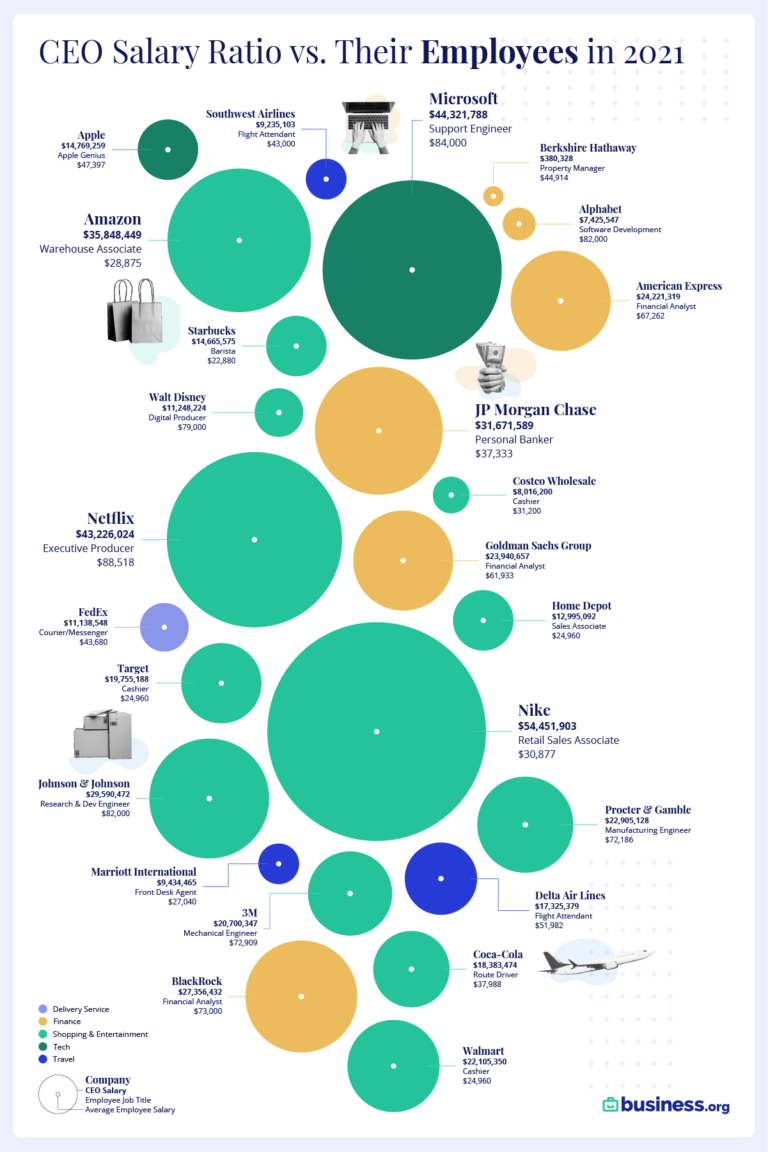💸 See if your business qualifies for a tax credit worth up to $26k per employee. 📞 Call Now: 855-979-9597
CEO vs. Employee Salaries at America’s Top Companies
We are committed to sharing unbiased reviews. Some of the links on our site are from our partners who compensate us. Read our editorial guidelines and advertising disclosure.
There has long been a disconnect between the average wage earner and the top percentage of wage earners. The best illustration of this fact is that the wage rate of America’s CEOs1 has been growing much faster than the middle and lower brackets of wage earners.
The pandemic has served to exacerbate the gap between CEOs and the average worker. While many have suffered and lost their jobs, CEOs have kept getting raises. So what exactly does the disparity between CEOs and average wage earners look like? Let’s dig into the numbers.

Key findings
- The top three companies with the largest wage inequality are Nike, Amazon, and Walmart.
- The three companies with the least amount of wage inequality are Berkshire Hathaway, Alphabet (Google’s parent company), and Walt Disney.
- The average CEO earns $21.45 million dollars a year. That’s 400 times more than what an average employee earns ($51,394).
CEO Salary Comparison to Average Employee Wage
What do these numbers mean?
Let’s start by taking a look at Alphabet, the parent company of Google. CEO Sundar Pichai makes $7,425,547 per year while the average Alphabet employee makes $82,000 per year. Alphabet has one of the lowest wage gaps. That said, the average employee would still have to work 3,622 hours a week to earn what Sundar Pichai earns.
It would be silly to say that the average employee should make the same amount as the CEO. Obviously the job of CEO is extremely critical to the success of a company. And businesses that want to be successful will dangle huge salaries in the hopes of snagging a capable CEO. These realities and market forces can’t be discounted.
But, businesses that pay CEOs exorbitant salaries risk perpetuating the old adage of making the rich richer while giving everyone else mere scraps for a living. The problem couldn’t be more obvious in a business like Nike, where CEO John J. Donahoe II is pulling down $54,451,903 per year while the average employee makes a measly $30,877.
The wage gap between the common individual and the uncommonly overpaid CEO should anger workers. The only problem is, there’s very little a worker struggling to make ends meet in an uncertain economy can do to be a catalyst for change.
By signing up I agree to the Terms of Use and Privacy Policy.
What’s the best way forward?
The first step to progress is recognizing when businesses have problematic wage structures. The second step is generating social pressure to slash CEO compensation and raise employee wages.
While legislation could be put forth to try and force businesses to have a fairer compensation hierarchy, the reality of lawmaking these days is that the wealthy have all the lobbying power and the government is wearing far too many hats to efficiently get the job done.
Real change can only come from individuals and groups willing to take big businesses to task for unsavory compensation practices. On the other hand, businesses should look to companies with fairer wage structures as examples of how to run an effective business without a massive wage disparity. Want to learn how to build a company where employees want to stay? Sign up for our newsletter for HR tips and more.
Of course, there should always be reasonable wage increases as employees climb the corporate ladder. This encourages workers to seek improvement and promotion. But, if businesses want to attract top talent at all levels of their company, competitive wages are a must. That’s just smart business sense.
If you're an employee feeling dissatisfied with your company’s wage structure, consider starting your own business as an alternative to climbing the corporate ladder. Not sure where to start? Check out our guides for small business ideas and how to start a small business.
Methodology
To obtain the salaries of each company’s CEO, we referenced Salary.com’s2 breakdown of the proxy statements submitted to the SEC. Their earnings consisted of salary, bonuses, and equity. CEO earnings per hour and per minute were calculated using a 40-hour work week and 52 working weeks in a year. Employee salaries were collected using crowdsourced data from Payscale.com3
Sources
- Economic Policy Institute, “State of Working America Wages 2019”. February 20, 2020, Accessed October 7, 2021.
- Salary.com, “Executive Compensation”. Accessed October 7, 2021.
- Payscale.com. Accessed October 7, 2021.





